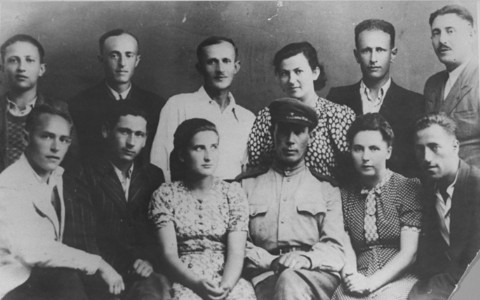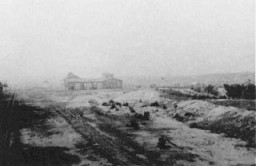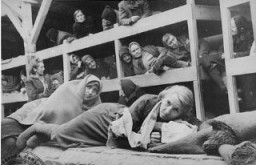
Sobibor
To carry out the mass murder of Europe's Jews, the SS established killing centers devoted exclusively or primarily to the destruction of human beings in gas chambers. Sobibor was among these killing centers. It was one of three killing centers linked to Operation Reinhard, the SS plan to murder almost two million Jews living in the German-administered territory of occupied Poland, called the General Government.
-
1
From April 1942 until mid-October 1943, the German SS and their auxiliaries killed at least 167,000 people at Sobibor.
-
2
For the killing operations at Sobibor and the other Operation Reinhard camps, the SS drew upon staff and experience gained in the mass murder of patients with disabilities in the "euthanasia" (T4) program in Germany.
-
3
On October 14, 1943, the Jewish resistance in Sobibor launched an uprising during which some 300 prisoners escaped. Most of the escapees were subsequently hunted down and killed, but some 50 survived the war.
German SS and police authorities constructed Sobibor in the spring of 1942. It was the second of three killing centers established as part of Operation Reinhard (also known as Aktion Reinhard or Einsatz Reinhard). Operation Reinhard was the plan to murder the Jews of the General Government (Generalgouvernement). It was implemented by the SS and Police Leader in Lublin, SS General Odilo Globocnik.
The Sobibor killing center was established near the small village of Sobibor. This was a thinly populated, swampy area about three miles west of the Bug (Buh) River and what is today the eastern border of Poland. It was located about 50 miles east of the city Lublin, 24 miles north of the town Chelm, and 5 miles south of the town Wlodawa. During the German occupation of Poland in World War II, this area was in the Lublin District of the General Government.
The Sobibor camp was built along the Lublin-Chelm-Wlodawa railway line just west of the Sobibor railway station. A nearby spur connected the railway to the camp and was used to offload prisoners from incoming transports. A dense forest of pine and birch shielded the site from view.
At its largest extension, the camp covered a rectangular area of 1,312 by 1,969 feet (an area just larger than 33 soccer fields). Branches woven into the barbed-wire fence and trees planted around the perimeter camouflaged the site. A 50-feet-wide minefield surrounded the camp.
Deportations to Sobibor
German SS and police officials conducted deportations to Sobibor between May 1942 and the fall of 1943. Between late July and September 1942, deportations by train to Sobibor from points south were suspended. During this time, repairs were made on the Chelm-Lublin railway.
German SS and police officials deported Jews to Sobibor primarily from the ghettos of the northern and eastern regions of Lublin District, such as the Chelm ghetto. The Germans also deported Jews to Sobibor from German-occupied Soviet territory, Germany itself, Austria, Slovakia, Bohemia and Moravia, the Netherlands, and France. In all, the Germans and their auxiliaries killed at least 167,000 people at Sobibor.
The Staff at Sobibor
Approximately 50 German and Austrian personnel served at the site. As at Belzec and Treblinka—the other Operation Reinhard killing centers—the German staff derived almost exclusively from the T4, or “euthanasia,” program personnel. Sobibor's first official commandant was Austrian policeman Franz Stangl. Initially, Stangl had served as deputy administrative director of the Hartheim "euthanasia" killing center. There, he was charged with security. He had also done similar tasks at Bernburg before his transfer to the Lublin District. On witnessing his first gassings at Sobibor, Stangl reported with surprise, “it was exactly like the gas chambers in Castle Hartheim.”
Stangl’s deputy was fellow Austrian Franz Reichleitner. Reichleitner had also worked with Stangl at Hartheim. In August 1942, he succeeded Stangl as commandant of Sobibor. Stangl himself was transferred to Treblinka. Reichleitner remained commandant until Sobibor was liquidated in November 1943.
In addition to the German personnel at Sobibor, there was a police auxiliary guard unit. This unit consisted of 90 to 120 men. All of its members were either former Soviet prisoners of war (POWs) of various nationalities or Ukrainian and Polish civilians selected or recruited for this purpose. These men were trained at the Trawniki training camp. The Trawniki camp was a special facility of SS General Odilo Globocnik.
The Topography of Sobibor
The Sobibor killing center was divided into three “camps.” It consisted of an administration area, a reception area, and a killing area.
The administration area included the site’s entrance gate, railway ramp, and living quarters for the SS men and Trawniki guards. It also included Camp I where a relatively small number of Jewish prisoners labored in workshops. Most of these prisoners were also housed here.
Camp II comprised the reception area. Guards forced arriving Jewish prisoners into this area after they disembarked from the transports. This part of the complex housed the undressing barracks. It also contained the storehouses which held the victims’ clothes and belongings.
In the northwestern corner of Camp II, a narrow, enclosed path connected the reception area with Camp III. This path was termed the “tube” [“Schlauch,” in German].
Camp III was the killing area. This is where the gas chambers and burial pits were located. It was also the location of the barracks that housed a guard unit and the Jewish laborers who worked in this part of the camp. Unlike at the Belzec complex, the actual murder site was further removed from the rest of the camp. The prisoners deployed in Camp III had no contact with the rest of the Jewish prisoners in Sobibor. Thus, it took several weeks before the first Jewish forced laborers in Camps I and II learned about the fate of their loved ones who had accompanied them to Sobibor or of their proximity to the gas chambers.
Mass Murder
Camp authorities began regular gassing operations in early May of 1942. Prior to that, they conducted some early experimental gassings to test the efficacy of the gas chambers.
Transports of 40 to 60 freight cars would arrive at the Sobibor railway station. Next, 20 cars at a time were taken to Camp I. There the camp guards ordered victims out of the trains and onto the platform. German SS and police officials announced that the deportees were to be sent to labor, but that first they were to bathe and undergo disinfection. The Germans ordered the Jews to abandon their belongings and to undress in the barracks. Men were usually separated from women and small children. Finally, guards forced the Jewish prisoners to run through the "tube." The “tube” led directly into gas chambers, which were deceptively labeled as showers. The women's hair was shorn in a special barracks inside the "tube." Once the gas chamber doors were sealed, guards in an adjacent room started an engine that piped carbon monoxide gas into the gas chambers. The people inside the gas chambers were killed. Arriving Jewish prisoners who were too ill, weak, or elderly to walk to the gas chambers were taken to Camp III and shot in an open pit. Then, when all the people from the 20 rail cars had been killed, the whole process was repeated with the next set of cars. The process continued until the entire transport had been murdered.
Sonderkommandos and Forced Labor
From each transport, camp officials chose a small handful of prisoners to supplement the forced labor supply at Sobibor. They selected prisoners who appeared fit or skilled.
Some of the prisoners selected to be forced laborers were forced to work in the killing area of Camp III. These groups were known as Sonderkommandos (special detachments). They were tasked with removing bodies from the gas chambers and burying the victims in mass graves.
Other prisoners selected for temporary survival worked in the administration and reception areas. They facilitated detraining, disrobing, relinquishment of valuables, and movement of the Jewish prisoners into the “tube.”
In the summer of 1942, camp personnel deployed Jewish forced laborers from various locations in Lublin District to exhume the mass graves at Sobibor. They then ordered the forced laborers to burn the bodies on open-air “ovens” made from rail track. This measure aligned with the efforts of the Sonderkommando 1005. That detachment was tasked with excavating and destroying evidence of Nazi mass murder in the German-occupied east.
The Sobibor Uprising
In early 1943, the Jewish prisoners became concerned as they sensed that killing operations in Sobibor were winding down. They also learned that Belzec had been dismantled and all surviving prisoners liquidated. In response, the prisoners organized a resistance group in the late spring of 1943. In late September, this group was augmented in numbers and military training skills by the arrival of some Jewish Red Army POWs from the Minsk ghetto. The prisoners planned an uprising following the murder of key German camp officials. On October 14, 1943, with approximately 600 prisoners left in the camp, those who knew the plan initiated the revolt. The prisoners killed 11 German personnel and a few Trawniki-trained guards. Around 300 prisoners succeeded in breaking out of the killing center that day. Approximately 100 were caught in the dragnet that followed the uprising. Some 50 prisoners escaped Sobibor and survived the war.
Dismantling Sobibor
After the revolt, German camp officials and the Trawniki-trained guards dismantled the killing center. They also shot the Jewish prisoners who had not escaped during the uprising. Pursuant to discussions in the SS hierarchy in the summer of 1943, the Germans had intended to transform the facility to be used for other purposes. Initially, it was to be a holding pen for women and children deported west from occupied Belarus after their fathers and husbands had been murdered in what the Germans called anti-partisan operations. Later, they considered converting the site into an ammunition supply depot. There is no information that new prisoners ever arrived in Sobibor after the killing center was dismantled. However, a small Trawniki-trained guard detachment remained there through at least the end of March 1944.
Sobibor was the last of the Operation Reinhard camps to be liquidated. As at Belzec and Treblinka, the area was plowed over. The site of the Sobibor killing center was planted with a pine forest.
Photographic Evidence: The Sobibor Perpetrator Collection
For many decades there were only two known photographs depicting the Sobibor killing center in operation. In 2020, the Holocaust Museum acquired more than 50 previously unknown images from Sobibor that had been the property of camp deputy commandant Johann Niemann. These photos are part of a larger collection donated by Niemann's descendants. They provide never-before-seen views of the killing center. Among them are images of barracks buildings, workshops, and SS and Ukrainian guards.
Some of these photographs depict Sobibor personnel laughing and posing for vanity shots even as they helped implement the mass murder of at least 167,000 innocent Jews. Niemann was killed during the Sobibor prisoner revolt on October 14, 1943, after which the camp was closed.
Further Reading
Arad, Yitzhak. Belzec, Sobibor, Treblinka: The Operation Reinhard Death Camps. Bloomington, IN: Indiana University Press, 1987.
Blatt, Thomas. From the Ashes of Sobibor: A Story of Survival. Evanston, IL: Northwestern University Press, 1997.
Raschke, Richard. Escape from Sobibor. Boston: Houghton Mifflin, 1982.
Schelvis, Julius. Sobibor: A History of a Nazi Death Camp. Translated by Karin Dixon. Oxford/New York: Berg, 2007.







